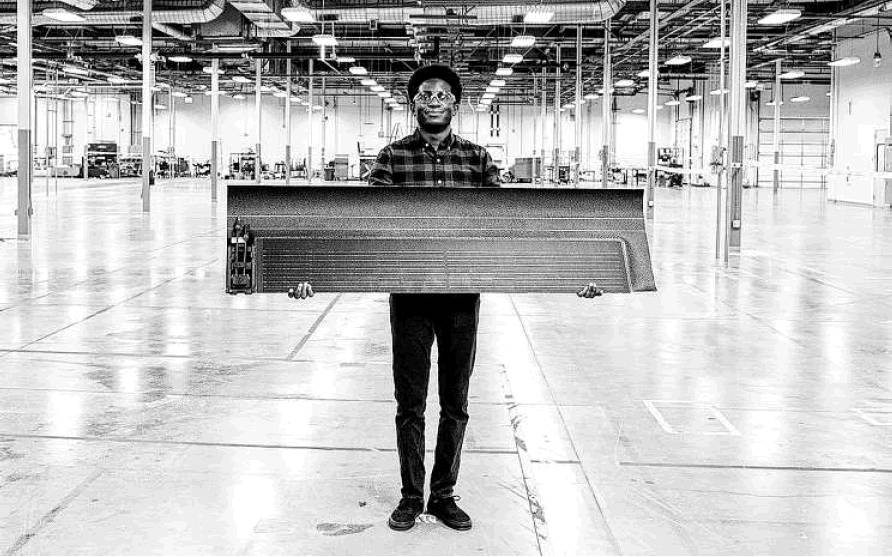ENERGY TRANSITION
Roofing company slims down prices for solar shingles
By Tik Root WASHINGTON POST
Thousands of Americans install solar energy systems on their roofs each year. Most commonly, that means solar panels mounted on racks, but another option may become more accessible: solar shingles.
Last week, one of the largest roofing companies in the United States began selling a new solar shingle product. The aim is to drive the cost of installation down and the rate of solar adoption up.
“What we’ve done is we’ve created a shingle that has solar properties,” said Martin DeBono, president of GAF Energy, which is a sibling company of GAF, a roofing manufacturer with a network of more than 10,000 contractors across the country. “While someone is getting a new roof, we can offer them a solar roof.”
The solar shingles are a bit bigger and about twice as heavy as traditional shingles, but look remarkably similar.
The top half is nailed to the roof, while the bottom half overlaps the previous shingle and remains exposed. The outward-facing section of a solar shingle is made of photovoltaic cells, rather than asphalt. The panels collect energy and then transfer it through wires on the end of each shingle that daisy-chain together.
The goal is to lower costs by combining roofing and solar installation, said DeBono, who uses his own home as an example. His traditional roof, he said, cost around $28,000, and the solar panels he installed would be around $24,000, for a total price tag of around $52,000, or about $44,000 after rebates and incentives. In comparison, he estimated a GAF Energy solar roof would cost approximately $42,000 and drop to around $30,000 after incentives, saving about $14,000.
GAF Energy’s new shingles come with a 25-year warranty, which the company said should be enough time for a customer to recoup the cost of the system through reduced utility bills — especially in states where electricity is more expensive. It’s a proposition that the company hopes will make its product more successful than previous attempts.
Solar shingles have been around in some form for decades, said Zachary Holman, a professor of engineering at Arizona State University who specializes in solar technology. “Many people have played in this space,” he said, including Tesla and other roofing companies such as CertainTeed. Another company, Maxeon Solar Technologies, is aiming to make adhesive solar panels.
“I’d see it more on supply chain and business innovation,” Holman said of this latest effort, pointing to GAF’s expansive installer network and the fact that the shingles can be nailed. “They have channels for distribution that I think all of the other players — including Tesla — haven’t had access to.”
Rooftop solar on small buildings could theoretically meet a quarter of electricity demand in the United States, a 2016 assessment from the National Renewable Energy Laboratory found. But putting efficient, durable and eye-pleasing solar panels on roofs at a reasonable cost hasn’t been easy. According to the Solar Energy Industry Association, less than 3 percent of single-family homes have any type of solar system installed.
Costs have dropped rapidly in the past decade, though, and the Department of Energy says that “solar power is more affordable, accessible, and prevalent in the United States than ever before.” The department has a guide for exploring solar at home — including tools for estimating a home’s rooftop solar potential and navigating the many available federal, state and local solar incentives, and credits. There are also resources for learning about the variety of lease, loan and other financing options that exist.
And, as solar shingles demonstrate, the market is continually shifting.
“It’s flush, it’s cool and you get all the power you need. But there are risks,” said Cherif Kedir, president of the Renewable Energy Test Center, which tests and certifies products for a range of companies, including GAF Energy. One risk is that “you have a product that is in direct contact with your roof,” Kedir said. That can lead to heat management issues, Holman said.
While traditional solar modules have air gaps of a couple of inches to a few feet from the roof, solar shingles would not. That means the shingles may get hotter, which could reduce their efficiency and also potentially make it harder to keep the inside of a home cool.
“The main challenge is convincing me it’s going to last,” said David Fenning, director of the Solar Energy Innovation Laboratory at the University of California at San Diego. Even with a warranty, he said, “no one wants problems with their roofs.”
